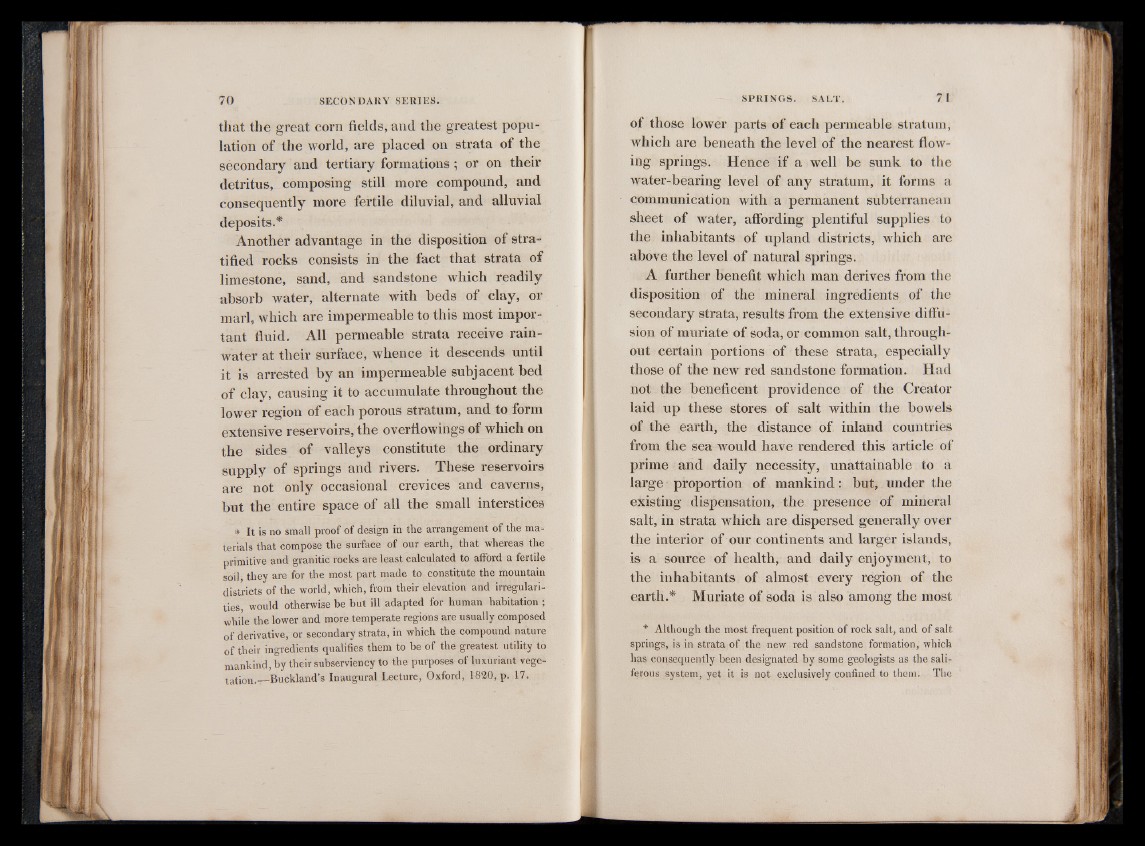
that the great corn fields, and the greatest population
of the world, are placed on strata of the
secondary and tertiary formations; or on their
detritus, composing still more compound, and
consequently more fertile diluvial, and alluvial
deposits.*
Another advantage in the disposition of stratified
rocks consists in the fact that strata of
limestone, sand, and sandstone which readily
absorb water, alternate with beds of clay, or
marl, which are impermeable to this most important
fluid. All permeable strata receive rainwater
at their surface, whence it descends until
it is arrested by an impermeable subjacent bed
of clay, causing it to accumulate throughout the
lower region of each porous stratum, and to form
extensive reservoirs, the overflowings of which on
the sides of valleys constitute the ordinary
supply of springs and rivers. These reservoirs
are not only occasional crevices and caverns,
but the entire space of all the small interstices
* It is no small proof of design in the arrangement of the ma^
terials that compose the surface of our earth, that whereas the
primitive and granitic rocks are least calculated to afford a fertile
soil, they are for the most part made to constitute the mountain
districts of the world, which, from their elevation and irregularities,
would otherwise be but ill adapted for human habitation ;
while the lower and more temperate regions are usually composed
of derivative, or secondary strata, in which the compound nature
of their ingredients qualifies them to be of the greatest utility to
mankind, by their subserviency to the purposes of luxuriant vegetation.—
Buckland’s Inaugural Lecture, Oxford, 1820, p. 17.
of those lower parts of each permeable stratum,
which are beneath the level of the nearest flowing
springs. Hence if a well be sunk to the
water-bearing level of any stratum, it forms a
communication with a permanent subterranean
sheet of water, affording plentiful supplies to
the inhabitants of upland districts, which are
above the level of natural springs.
A further benefit which man derives from the
disposition of the mineral ingredients of the
secondary strata, results from the extensive diffusion
of muriate of soda, or common salt, throughout
certain portions of these strata, especially
those of the new red sandstone formation. Had
not the beneficent providence of the Creator
laid up these stores of salt within the bowels
of the earth, the distance of inland countries
from the sea would have rendered this article of
prime and daily necessity, unattainable to a
large proportion of mankind: but, under the
existing dispensation, the presence of mineral
salt, in strata which are dispersed generally over
the interior of our continents and larger islands,
is a source of health, and daily enjoyment, to
the inhabitants of almost every region of the
earth.* Muriate of soda is also among the most
* Although the most frequent position of rock salt, and of salt
springs, is in strata of the new red sandstone formation, which
has consequently been designated by some geologists as the saliferous
system, yet it is not exclusively confined to them. The